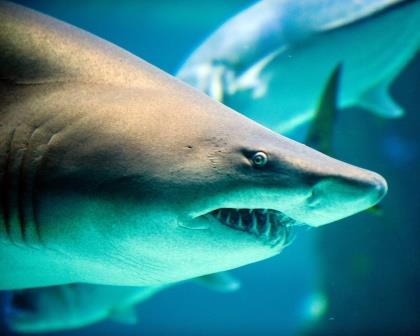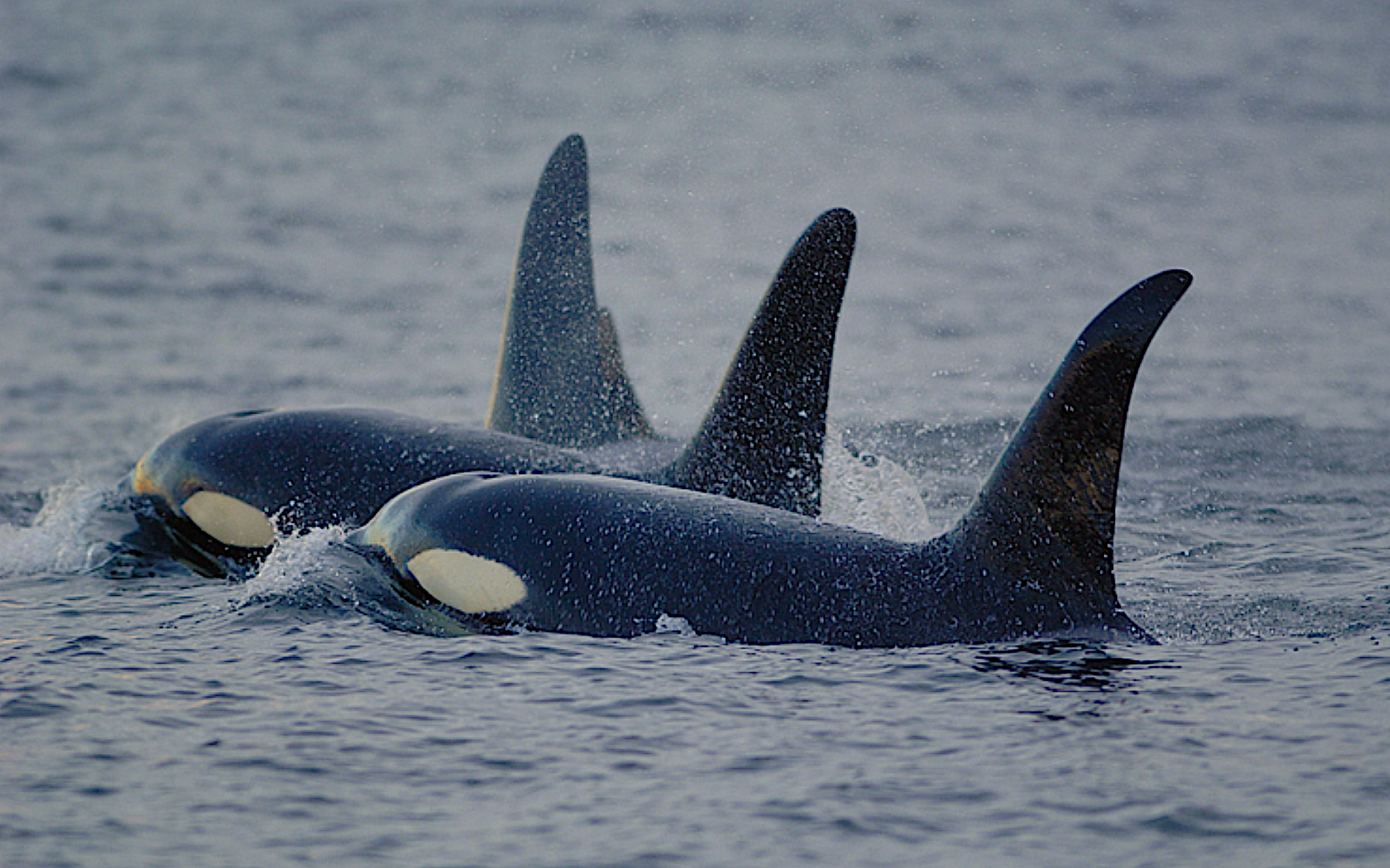A toddler explodes into the dimly lit “Graveyard of the Atlantic” exhibit hall at the North Carolina Aquarium on Roanoke Island. He squeals with excitement, “Mommy, Mommy. Sharks! See the sharks!”
He presses his face against the see-through wall of the two-story ocean tank, mesmerized by the motion of the sharks and a silvery array of aquatic life before him. As one of the sharks swims close to his vantage point, the boy exclaims with delight. “Wow!”
The “wow” factor is an important part of the visitor experience at the state’s three aquariums, says David Griffin, director of North Carolina Aquariums. The state-supported public education facilities at Roanoke Island, Fort Fisher and Pine Knoll Shores are designed “to inspire appreciation and conservation of North Carolina’s aquatic environments.”
“Our approach to environmental education can’t be cut and dry. We have to make it fun, entertaining and engaging, so that visitors walk out knowing more about North Carolina’s aquatic life because of their experience,” Griffin says.
Somewhere between the toothy sharks swimming in the ocean tank and grinning alligators soaking in a freshwater pond beneath a soaring conservatory roof, one thing becomes clear: This is not your daddy’s aquarium.
A lot has changed since the three sites opened in 1976 as Marine Resource Centers meant to enhance coastal and marine science and education for researchers, teachers and the public.
With the renaming of the centers as aquariums in 1986 came modest expansion and an evolving educational mission. That same year, the North Carolina Aquarium Society, a statewide nonprofit group, was established to help raise public interest and financial support for the three aquariums.
Attendance grew as coastal tourism flourished.
“The three aquariums have become a major component of North Carolina’s tourism industry,” says Robert Roush, public information officer at the Fort Fisher Aquarium. “With about a million visitors combined annually, they are among the top attractions in the state. Studies show they directly contribute more than $27 million to the state’s economy each year,” he says.
EXTREME MAKEOVERS
By 1989, state officials recognized that the aging aquariums couldn’t keep pace with increasing attendance — and visitor expectations.
So the N.C. General Assembly budgeted money to implement “extreme makeovers” at all three sites. The aquarium society pledged to raise additional donations from the private sector to augment the $15 million state allocation for each project. In addition, part of the admission fees from each aquarium would be dedicated to the building program.
The expansion program would enable each facility to grow in size, increase live animal exhibits, create state-of-the-art interactive displays, and multiply education programs and events. Each could portray the biodiversity of aquatic life within varied habitats — from freshwater streams, ditches and swamps to tidal rivers, shallow sounds and ocean depths.
The challenge for today’s aquariums, zoos and living museums is to grab the attention of a generation accustomed to the multimedia world of entertainment and education, says JP McCann, director of the Roanoke Island facility. “New facilities allow us to integrate education into an entertaining delivery system,” he says.
A transformed Roanoke Island aquarium — first to come on line in 2000 after a two-year rebuilding process — highlights aquatic life in “The Waters of the Outer Banks.” Four sand tiger sharks prowl its 285,000-gallon ocean tank that is complete with a sunken model of the Civil War ironclad, the USS Monitor.
Then came Fort Fisher in 2002, featuring “The Waters of the Cape Fear.” Its 235,000-gallon tank features inhabitants of an offshore ocean reef, including sharks, stingrays, groupers and moray eels.
The timetable for the Pine Knoll Shores Aquarium hit a snag in 1999. Renovation funds were diverted to help with recovery efforts when multiple hurricanes, including Hurricane Floyd’s historic flooding, devastated Eastern North Carolina.
The wait will be over in May 2006 when the new facility opens its doors on a “Mountains to Sea” theme, complete with a two-story mountain waterfall. Other features include a 310,000-gallon ocean tank, with a full complement of sea life swimming about a replica of U-352, a German submarine that sank off Cape Lookout in 1942.
While the aquarium is closed to the public during the construction, the Pine Knoll Shores staff is operating programs from a former Atlantic Beach supermarket. Part of the aquarium’s collection waits out the makeover in holding tanks in refitted grocery store space. Others are being cared for at sister aquariums.
NATURE AND NURTURE
There’s much more to these aquariums than meets the public eye, Griffin says. The first thing you notice as you push through any “staff only” door is the hospital-like environment. Cleanliness rules.
A small, efficient and highly skilled team of specialists is dedicated to the health and welfare of more than 2,500 living creatures, Griffin adds. The work of a core staff of full- and part-time employees is amplified by a cadre of trained volunteers, junior aquarists and summer interns who assist in nearly every phase of operation.
What’s the most basic life support system in an aquarium? Water, of course. But Frank Hudgins, director of husbandry and operations at the Roanoke Island site, will tell you that it’s not that simple. Sophisticated systems filter water and regulate temperatures for each exhibit. Saltwater is “manufactured” on site to control species-specific salinity needs and to ensure a disease-free environment.
Mother Nature plays a key role in providing more than 270 indigenous species, says Paul Barrington, Hudgins’ counterpart at Fort Fisher. Along with members of their respective husbandry teams, Barrington and Hudgins make frequent “fishing” trips with local commercial or recreational anglers to net catch or trap needed finfish or shellfish species. Local dive clubs also help fill specific needs.
Permits from the N.C. Division of Marine Fisheries (DMF) authorize species collection from the state’s saltwater bodies. The aquariums also have special permits and help from the N.C. Wildlife Resources Commission to gather freshwater species from the mountains to the coast.
What can’t be found in the wild must be acquired from other aquariums by purchase or an exchange agreement — or bred in-house. A successful captive-breeding program at Fort Fisher addresses the supply side of some hard-to-collect species.
Nature obliges in the case of sea horses, which can release hundreds of babies each month. Finding suitable “baby food” is another matter. Aquaculture researchers at the University of North Carolina at Wilmington suggested microscopic animals called rotifers might be just the ticket. Now, rotifers are “cooked” up to nurture the tiny creatures.
The in-house breeding programs for sea horses, moon jellyfish and sea nettles is so successful, the aquarium provides animals to sister aquariums as well as aquariums around the country.
But nature needs more scientific coaxing when it comes to breeding yellow stingrays. That’s where a collaborative agreement with the North Carolina State University College of Veterinary Medicine comes in. A joint study to learn more about yellow stingrays’ reproduction process yielded the live birth of five healthy pups in 2004. An ultrasound borrowed from the North Carolina Zoo helped determine the due date. And, the veterinary college’s Craig Harms administered a human hormone to induce labor and make local history.
Often, research opportunities literally come to the doorstep of the aquariums. That’s how Joanne Harcke became involved with turtle research while serving as research coordinator at Roanoke Island. What began as an informal partnership with state and federal agencies to rehabilitate stranded or injured sea turtles now is a far-reaching research project. Before being released, turtles are fitted with transmitters so scientists — and the public — can track them online at www.ncaquariums.com/turtletrails.
Harcke, now at Fort Fisher, says the program is providing new information about turtles’ mysterious migration patterns.
“Research, whether applied or incidental, is an important part of the aquarium mission. We observe, document and relay our findings to the scientific community through aquarium and university networks,” Barrington explains.
The North Carolina Aquariums soon could have an expanded research role to play in efforts to restore failing oyster populations in state waters. A bill introduced in the state senate seeks $300,000 to study the creation of oyster hatcheries at the aquariums in collaboration with North Carolina Sea Grant, DMF and university scientists.
“It’s an exciting prospect,” Griffin says.
THE TAKE-HOME MESSAGE
At Roanoke Island, a crowd of mostly adults encircles the touch tank where stingrays play follow the leader. Volunteer Fred Bamonte encourages the visitors to reach down to touch the cruising animals.
“Go ahead. Put your fingers in the water and touch their wings. They are as soft as velvet. Don’t ignore them — or they’ll come up to you and splash you for attention,” he warns.
On cue, the largest ray pops up and makes a splashing motion with its wings. Surprised visitors shyly dangle fingers and hands in the shallow tank to experience the velvet touch. Bamonte points out the guitarfish, a small shark, making lazy circles near the tank’s bottom. “Go ahead, touch it so you can tell your friends you touched a shark,” he jokes.
Then, Bamonte lifts a menacing-looking horseshoe crab from the bottom to give his now-captive audience a close look at a creature that has stood the test of time. He explains the horseshoe crab’s prehistoric genealogy and its modern pharmaceutical benefits.
“That’s why protecting aquatic life is so important. Who knows what other creature may hold a potential cure for cancer,” he asks rhetorically.
The touch tank galleries, popular spots for visitors, play an important role in helping visitors see aquatic life and the environment in a new way, says McCann.
Like his fellow aquarium directors, he makes daily rounds through the aquarium to get a firsthand read on visitor satisfaction — from a youngster’s fascination with sharks to a senior citizen’s awe at the first touch of a stingray.
“Some spend hours reading every word at every exhibit,” McCann says. “Some rush from exhibit to exhibit.”
The important thing, the directors and staff members agree, is that visitors leave with a foundation of knowledge about the abundance and diversity of aquatic life in North Carolina.
“The public gets a larger environmental picture by viewing these animals in relation to other species within a certain habitat. We have an opportunity to show our visitors the wonders of these waters and where they fit into the story,” Barrington observes.
Each animal serves as a messenger for its brethren in the wild to show they are something of value and deserve to be respected and protected, he adds.
“We especially want our visitors to make the healthy environment/healthy animals/ healthy people connection,” Griffin says. “We want to truly inspire an awareness for the personal role each of us plays in protecting the environment.”
This article was published in the High Season 2005 issue of Coastwatch.
For contact information and reprint requests, visit ncseagrant.ncsu.edu/coastwatch/contact/.
- Categories:



